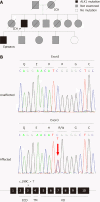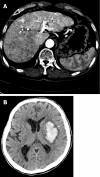Gastric angiodysplasia in a hereditary hemorrhagic telangiectasia type 2 patient
- PMID: 22553411
- PMCID: PMC3332300
- DOI: 10.3748/wjg.v18.i15.1840
Gastric angiodysplasia in a hereditary hemorrhagic telangiectasia type 2 patient
Abstract
Hereditary hemorrhagic telangiectasia (HHT) is a rare autosomal-dominantly inherited disease that occurs in approximately one in 5000 to 8000 people. Clinical diagnosis of HHT is made when a person presents three of the following four criteria: family history, recurrent nosebleeds, mucocutaneous telangiectasis, and arteriovenous malformations (AVM) in the brain, lung, liver and gastrointestinal (GI) tract. Although epistaxis is the most common presenting symptom, AVMs affecting the lungs, brain and GI tract provoke a more serious outcome. Heterozygous mutations in endoglin, activin receptor-like kinase 1 (ACVRL1; ALK1), and SMAD4, the genes involved in the transforming growth factor-β family signaling cascade, cause HHT. We report here the case of a 63 year-old male patient who presented melena and GI bleeding episodes, proven to be caused by bleeding from multiple gastric angiodysplasia. Esophagogastroduodenoscopy revealed multiple angiodysplasia throughout the stomach. Endoscopic argon plasma coagulation was performed to control bleeding from a gastric angiodysplasia. The patient has been admitted several times with episodes of hemoptysis and hematochezia. One year ago, the patient was hospitalized due to right-sided weakness, which was caused by left basal ganglia hemorrhage as the part of HHT presentation. In family history, the patient's mother and elder sister had died, due to intracranial hemorrhage, and his eldest son has been suffered from recurrent epistaxis for 20 years. A genetic study revealed a mutation in exon 3 of ALK1 (c.199C > T; p.Arg67Trp) in the proband and his eldest son presenting epistaxis.
Keywords: Activin receptor-like kinase 1; Angiodysplasia; Epistaxis; Hereditary hemorrhagic telangiectasia; Intracranial hemorrhage.
Figures



Similar articles
-
Clinical presentation and treatment paradigms of brain arteriovenous malformations in patients with hereditary hemorrhagic telangiectasia.J Clin Neurosci. 2018 May;51:22-28. doi: 10.1016/j.jocn.2018.01.019. Epub 2018 Feb 23. J Clin Neurosci. 2018. PMID: 29483005
-
Hereditary Hemorrhagic Telangiectasia with Recurrent Epistaxis, Telangiectasia, Hepatic Arteriovenous Malformation, and a Poorly Developed Middle Cerebral Artery in a Patient with a Novel Mutation in the ACVRL1 Gene.Intern Med. 2025 Feb 1;64(3):477-480. doi: 10.2169/internalmedicine.3485-24. Epub 2024 Jul 4. Intern Med. 2025. PMID: 38960693 Free PMC article.
-
Mutations in the ENG, ACVRL1, and SMAD4 genes and clinical manifestations of hereditary haemorrhagic telangiectasia: experience from the Center for Osler's Disease, Uppsala University Hospital.Ups J Med Sci. 2018 Sep;123(3):153-157. doi: 10.1080/03009734.2018.1483452. Epub 2018 Sep 25. Ups J Med Sci. 2018. PMID: 30251589 Free PMC article.
-
Hemoptysis caused by hereditary hemorrhagic telangiectasia: A case report and literature review.Zhong Nan Da Xue Xue Bao Yi Xue Ban. 2025 Jan 28;50(1):149-154. doi: 10.11817/j.issn.1672-7347.2025.240251. Zhong Nan Da Xue Xue Bao Yi Xue Ban. 2025. PMID: 40457800 Review. Chinese, English.
-
Endoglin and alk1 as therapeutic targets for hereditary hemorrhagic telangiectasia.Expert Opin Ther Targets. 2017 Oct;21(10):933-947. doi: 10.1080/14728222.2017.1365839. Epub 2017 Aug 20. Expert Opin Ther Targets. 2017. PMID: 28796572 Review.
Cited by
-
Genetic Variants and Clinical Phenotypes in Korean Patients With Hereditary Hemorrhagic Telangiectasia.Clin Exp Otorhinolaryngol. 2021 Nov;14(4):399-406. doi: 10.21053/ceo.2020.02124. Epub 2021 Feb 26. Clin Exp Otorhinolaryngol. 2021. PMID: 33677851 Free PMC article.
-
Rendu-Osler-Weber disease: a gastroenterologist's perspective.Orphanet J Rare Dis. 2019 Jun 7;14(1):130. doi: 10.1186/s13023-019-1107-4. Orphanet J Rare Dis. 2019. PMID: 31174568 Free PMC article. Review.
-
Recurrent Gastrointestinal Hemorrhage in Treatment with Dasatinib in a Patient Showing SMAD4 Mutation with Acute Lymphoblastic Leukemia Philadelphia Positive and Juvenile Polyposis Hereditary Hemorrhagic Telangiectasia Syndrome.Hematol Rep. 2013 Jul 3;5(2):26-7. doi: 10.4081/hr.2013.e7. Print 2013 Jun 28. Hematol Rep. 2013. PMID: 23888243 Free PMC article.
-
Founder Effects in Hereditary Hemorrhagic Telangiectasia.J Clin Med. 2021 Apr 14;10(8):1682. doi: 10.3390/jcm10081682. J Clin Med. 2021. PMID: 33919892 Free PMC article. Review.
References
-
- Bideau A, Brunet G, Heyer E, Plauchu H, Robert JM. An abnormal concentration of cases of Rendu-Osler disease in the Valserine valley of the French Jura: a genealogical and demographic study. Ann Hum Biol. 1992;19:233–247. - PubMed
-
- Kjeldsen AD, Vase P, Green A. Hereditary haemorrhagic telangiectasia: a population-based study of prevalence and mortality in Danish patients. J Intern Med. 1999;245:31–39. - PubMed
-
- Dakeishi M, Shioya T, Wada Y, Shindo T, Otaka K, Manabe M, Nozaki J, Inoue S, Koizumi A. Genetic epidemiology of hereditary hemorrhagic telangiectasia in a local community in the northern part of Japan. Hum Mutat. 2002;19:140–148. - PubMed
-
- Lenato GM, Guanti G. Hereditary Haemorrhagic Telangiectasia (HHT): genetic and molecular aspects. Curr Pharm Des. 2006;12:1173–1193. - PubMed
Publication types
MeSH terms
Substances
Supplementary concepts
LinkOut - more resources
Full Text Sources
Medical
Miscellaneous

